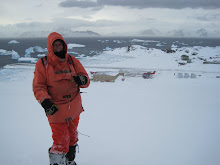Continuing from the last post.....
 |
| Bunk on the James Clark Ross |
 |
| One's own napkin! |
On the way to the Falklands the boat undertook several scientific experiments. This mainly involved working with the 'CTDs' (an oceanagraphic instrument which measures Conductivity (used to assess the saltiness / salinity of the water), Temperature and Depth in conjunction with automated sample bottles which enabled water samples to be taken at various depths .The CTD and water bottles were lowered to depths of up to 4000m in the Drake Passage! As the crane lowered it made the boat tip at a very alarming angle!
 |
| Elephant Island |
Realising that there was no chance of rescue by any passing ships, Shackleton decided to set out for South Georgia where he knew there was a whaling station. In one of the most incredible feats in the history of sailing and navigation, Shackleton sailed off with five other men on an 800-mile (1,287 km) voyage in an open lifeboat arriving at South Georgia almost two weeks later. His second in command, John Robert Francis “Frank” Wild remained in charge of the 21 other men on Elephant Island for more than four months while Shackleton led attempts to return with a rescue ship.
According to Frank Worsley, Shackleton's captain, the men pronounced the island with a silent 't' and an 'h' prefixed, which makes it into Hell-of-an-Island.
Tha amazing story of Shackleton and his crew did make my acute sea-sickness and raging toothache kind of pale into insignificance but I was very glad when the Falkland Islands came into view and I could stand on solid ground again!





No comments:
Post a Comment